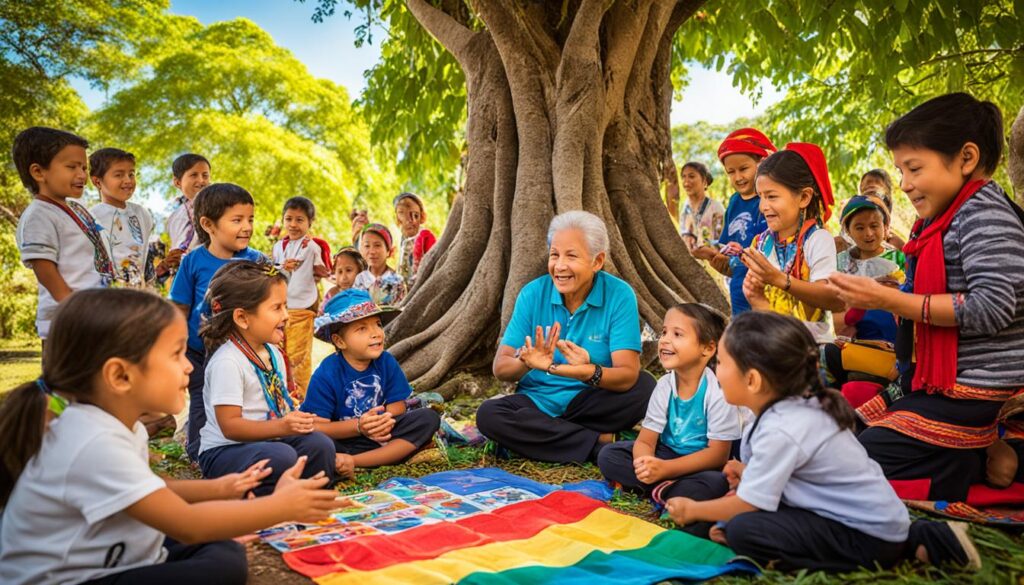Did you know that the Tai Lue language is spoken by about 555,760 people across China, Laos, Thailand, Myanmar, and Vietnam? This fascinating Southwestern Tai language, also known as Tai Lü or Dai Lue, has its own unique script, vibrant culture, and deep-rooted heritage. Exploring the Tai Lue language offers a gateway to understanding the rich tapestry of the Tai Lue community and their traditions.
From its diverse alphabet to its distinctive pronunciations, the Tai Lue language captivates learners with its intriguing nuances and authentic expressions. Whether you’re interested in Tai Lue translations, vocabulary, or pronunciation, delving into the Tai Lue dialect is an enriching journey that opens up a world of cultural discovery.
In the following sections, we will explore the history and origins of the Tai Lue people, delve into the intricacies of the Tai Lue language and script, highlight the cultural significance of the language, and provide insights into learning this unique language. Join us on this captivating linguistic and cultural odyssey as we unravel the wonders of the Tai Lue language and its importance in the diverse landscape of Thailand.
History and Origins of the Tai Lue People
The Tai Lue people, also known as Lü or Dai Lue, have a fascinating history and rich cultural heritage. They are believed to have originated in the Xishuangbanna district of Yunnan Province, China, in an area known as Sipsongpanna, meaning “Twelve Townships.” This region was inhabited by the Tai Lue people and served as a significant cultural and historical center for them.
Over time, the Tai Lue people gradually migrated to other regions, including Laos, Thailand, and Myanmar, where they established communities and made valuable contributions to the local cultures. Their interactions with neighboring communities influenced their customs, traditions, and ways of life, giving rise to a distinct Tai Lue identity.
The Tai Lue people have faced various challenges and witnessed historical changes throughout their existence. Despite these adversities, their language and culture have persevered and continue to thrive. Today, they preserve their unique heritage, maintaining a strong sense of cultural identity within their communities.
It is through their history and origins that we can gain a deeper understanding of the Tai Lue people, their cultural significance, and the enduring legacy they carry.
Interaction with Neighboring Communities
The Tai Lue people’s migration to different regions brought them into contact with neighboring communities, leading to a fascinating blend of cultural influences. Their interactions with groups such as the Dai, Shan, and Thai have shaped the Tai Lue culture and contributed to its diversity and vibrancy.
The Tai Lue people’s history is intertwined with the histories of other communities in the region. The cultural exchange and mutual influence have enriched not only the Tai Lue people themselves but also the broader cultural fabric of the areas they inhabit.
Cultural Preservations
The Tai Lue people place great importance on preserving and passing down their cultural heritage to future generations. Through traditional ceremonies, cultural performances, and religious rituals, they ensure that their customs and traditions are kept alive. The Tai Lue language plays a significant role in these practices, as it carries the history, stories, and beliefs of the community.
“Our language is the vessel that carries our culture and connects us to our ancestors. Preserving our language means preserving our identity and keeping our traditions alive.” – A Tai Lue community elder.
The Tai Lue people’s efforts to preserve their language are vital not only for their own community but also for the broader cultural diversity of Thailand. By nurturing and celebrating the Tai Lue language, they contribute to the cultural richness and heritage of the entire region.
The Tai Lue Language and Script
The Tai Lue language belongs to the Southwestern Tai language group within the Tai-Kadai language family. It is primarily spoken in China, Laos, Thailand, Myanmar, and Vietnam. The Tai Lue language has its own unique script, known as the New Tai Lue script, which is predominantly used in China. This script consists of 42 initial consonant signs, seven final consonant signs, 16 vowel signs, two tone letters, and one vowel shortening letter. It is quite similar to the Lanna script used in Northern Thailand.
The New Tai Lue script is visually captivating and adds to the allure of the Tai Lue language. Here is an example of the New Tai Lue script:

“The New Tai Lue script is a beautiful and intricate writing system, reflecting the cultural richness of the Tai Lue people.”
In addition to the New Tai Lue script, the traditional Lü script is also used to write the Tai Lue language, particularly for religious texts preserved in monasteries. The Tai Lue language is tonal, consisting of six contrastive tones, which add a melodic quality to the spoken language. It possesses unique phonological features, such as syllable-initial consonants and vowel qualities, that distinguish it from other languages in the region.
The Tai Lue script is an essential element of the Tai Lue cultural heritage and contributes to the preservation of their language and traditions.
Cultural Significance of the Tai Lue Language
The Tai Lue language holds immense cultural significance within the Tai Lue community. It serves not only as a medium of communication but also as a powerful expression of their culture and heritage. This language plays a central role in various traditional ceremonies, cultural performances, and religious rituals, allowing the Tai Lue people to connect with their history, stories, and ancestral traditions. The preservation of the Tai Lue language is crucial in order to sustain the cultural identity of the Tai Lue community.
Efforts are being made to promote and preserve the Tai Lue language and ensure its longevity. Cultural centers are being established, offering language programs and community initiatives that focus on language preservation. These initiatives aim to pass on the language to future generations, enabling them to inherit and perpetuate the rich cultural heritage of the Tai Lue people. By learning and preserving the Tai Lue language, individuals contribute to safeguarding the cultural traditions and practices that have been passed down through generations.
Preserving the Tai Lue language goes beyond the mere act of language preservation. It is an avenue to safeguard the wider Tai Lue culture, ensuring its continuation and vitality. The language serves as the vessel through which the intangible heritage of the Tai Lue people is transmitted, including their values, beliefs, and wisdom. Without the preservation of the language, this rich cultural tapestry would be at risk of fading away, and future generations would be deprived of the knowledge and essence of the Tai Lue community.
To sum up, the preservation of the Tai Lue language is essential for the cultural identity and heritage of the Tai Lue people. It allows them to maintain a deep connection to their roots and ensures the longevity of their traditions and customs. Through concerted efforts in language preservation, the Tai Lue community can thrive and flourish, keeping their cultural legacy alive for generations to come.
Learning the Tai Lue Language
Learning the Tai Lue language can be a truly enriching experience for individuals who have a keen interest in the culture and heritage of the Tai Lue people. Fortunately, there are several resources available that make it possible to learn Tai Lue effectively and conveniently.
One option for learning Tai Lue is to enroll in a Tai Lue language course. These courses provide structured learning programs designed to develop your vocabulary, improve pronunciation, and deepen your understanding of grammar. Tai Lue language courses often incorporate cultural aspects, allowing you to gain a holistic understanding of the language and its significance.
Another resource for learning Tai Lue is textbooks specifically tailored to language learners. These textbooks provide comprehensive lessons and exercises that guide you through the language at your own pace. They cover essential vocabulary, grammar rules, and common phrases, equipping you with the necessary skills to communicate effectively in Tai Lue.
Online resources also play a crucial role in learning Tai Lue. Websites, apps, and online courses offer interactive lessons, audio recordings, and language exercises that enhance your learning experience. These resources provide flexibility and accessibility, allowing you to study Tai Lue wherever and whenever it suits you.
Language exchange programs and cultural immersion
Additionally, language exchange programs can be an excellent way to practice your Tai Lue speaking skills with native speakers. Engaging in conversations and dialogues with native speakers will enhance your fluency and help you become more comfortable using the language in real-life situations.
Apart from formal learning resources, immersing yourself in the Tai Lue culture is invaluable for learning the language. Visiting Tai Lue communities, participating in cultural events, and experiencing the rich traditions firsthand provide immersive opportunities to practice the language, hear it spoken authentically, and appreciate its cultural context.
Learning Tai Lue not only enhances your linguistic skills but also fosters a deeper understanding and appreciation of the Tai Lue culture.
By combining formal learning resources, cultural immersion, and interactions with native speakers, you can embark on a comprehensive and rewarding journey to learn the Tai Lue language.

Overall, the availability of language courses, textbooks, online resources, and cultural immersion opportunities makes learning Tai Lue accessible to anyone interested in exploring this fascinating language. Embracing the Tai Lue language not only brings linguistic growth but also facilitates a profound connection and appreciation for the Tai Lue culture and heritage.
Tai Lue Language in Thailand
In Thailand, the Tai Lue language is predominantly spoken in the provinces of Chiang Kham, Chiang Mai, and Phayao. Chiang Kham holds the distinction of being considered the capital of Tai Lue culture in Thailand. Nestled in and around the town are numerous Tai Lue villages that serve as custodians of their language, traditions, and crafts. These communities dedicate themselves to preserving their cultural heritage through activities like weaving and silverware making.
The influence of the Tai Lue language extends beyond Chiang Kham, reaching other parts of northern Thailand where Tai Lue communities have found their home. Exploring these communities presents an invaluable opportunity to immerse oneself in the Tai Lue culture first-hand and engage with native speakers of the language, enabling a deeper understanding and appreciation of their unique linguistic and cultural traditions.
Tai Lue Communities in Thailand
| Province | Tai Lue Community |
|---|---|
| Chiang Kham | Tai Lue villages in and around Chiang Kham |
| Chiang Mai | Tai Lue communities in Chiang Mai province |
| Phayao | Tai Lue communities in Phayao province |
Importance of Preserving the Tai Lue Language
The preservation of the Tai Lue language is of utmost importance in safeguarding the cultural heritage and identity of the Tai Lue people. Language revitalization efforts are crucial to ensure that this unique language is passed down to future generations. By preserving the Tai Lue language, we not only preserve the rich linguistic traditions of the community but also contribute to the broader cultural diversity and linguistic heritage of Thailand as a whole.
Preserving the Tai Lue language is more than just protecting a means of communication; it is about sustaining a vital link to the past and facilitating intergenerational communication within the Tai Lue community. The language serves as a repository of knowledge, stories, and traditions that have been passed down through generations, reflecting the cultural autonomy and distinctiveness of the Tai Lue people.
Preserving the Tai Lue language is essential in fostering a sense of pride and belonging among the Tai Lue community. When individuals can communicate and express themselves in their native language, it strengthens their connection to their cultural roots, enhances their self-esteem, and fosters a deeper sense of identity and belonging.
“Language is not just words. It’s a culture, a tradition, a unification of a community, a whole history that creates what a community is. It’s all embodied in language.”, no name
Efforts to preserve the Tai Lue language include the establishment of language programs, cultural centers, and community initiatives that aim to promote the learning and use of the language. These initiatives provide opportunities for Tai Lue individuals of all ages to engage with their language, participate in language classes, and engage in cultural activities that reinforce their linguistic connection.
By preserving the Tai Lue language, we ensure that the cultural heritage and traditions of the Tai Lue people remain alive and vibrant. It is a testament to the resilience and determination of the community to preserve their unique identity and pass it on to future generations.
| Importance of Preserving the Tai Lue Language |
|---|
| Promotes Cultural Heritage |
| Fosters a Sense of Identity and Belonging |
| Strengthens Intergenerational Communication |
| Preserves Cultural Autonomy |
| Contributes to Linguistic Diversity |

Conclusion
The Tai Lue language is a vibrant and significant part of the Tai Lue culture and heritage. It serves as a vehicle for carrying the history, traditions, and identity of the Tai Lue people. Learning the Tai Lue language provides a unique opportunity to delve into the rich cultural tapestry of the Tai Lue community and gain a deeper understanding of their customs and way of life. By preserving and nurturing the Tai Lue language, we ensure that the legacy of the Tai Lue people continues to thrive and contribute to the cultural diversity not only of Thailand but also of the broader region.
Language is at the very core of a community’s cultural identity, and the Tai Lue language is no exception. Its preservation is crucial for maintaining the unique heritage and traditions that have been passed down through generations. The Tai Lue people’s linguistic and cultural autonomy is closely tied to the revitalization efforts of the Tai Lue language. Additionally, preserving this language fosters intergenerational communication, ensuring that the older generations can pass their wisdom and knowledge to the younger ones. It also instills a sense of pride and belonging among the Tai Lue community, strengthening their cultural cohesion.
As we navigate a rapidly changing world, it is vital to cherish and safeguard the linguistic diversity and cultural heritage that make our societies so rich and unique. The Tai Lue language is an invaluable part of Thailand’s linguistic tapestry, representing the mosaic of cultures and traditions that coexist within the country. By recognizing the significance of the Tai Lue language and supporting its preservation, we honor the contribution of the Tai Lue people to the cultural fabric of Thailand and celebrate the beauty of linguistic diversity.
FAQ
What is the Tai Lue language?
The Tai Lue language, also known as Tai Lü or Dai Lue, is a Southwestern Tai language spoken by about 555,760 people in China, Laos, Thailand, and Myanmar.
Where is the Tai Lue language primarily spoken?
The Tai Lue language is primarily spoken in Xishuangbanna Dai Autonomous Prefecture in Yunnan Province, China. It is also spoken in northern provinces of Laos, Nan and Phayao provinces in Thailand, and Shan State in Myanmar.
What script is used for writing the Tai Lue language?
The Tai Lue language has its own unique script, known as the New Tai Lue script, which is used in China. It is also written with the Lanna script in Thailand.
What is the cultural significance of the Tai Lue language?
The Tai Lue language is not only a means of communication but also a significant part of the Tai Lue culture and heritage. It is used in traditional ceremonies, cultural performances, and religious rituals.
How can I learn the Tai Lue language?
There are various resources available for learning Tai Lue, including language courses, textbooks, online resources, and language exchange programs. Immersing oneself in the language and culture by practicing with native speakers, visiting Tai Lue communities, and participating in cultural events is also recommended.
Where in Thailand is the Tai Lue language spoken?
The Tai Lue language is primarily spoken in the provinces of Chiang Kham, Chiang Mai, and Phayao. Chiang Kham is considered the capital of Tai Lue culture in Thailand, and there are several Tai Lue villages in and around the town.
Why is it important to preserve the Tai Lue language?
The preservation of the Tai Lue language is crucial for maintaining the cultural heritage and identity of the Tai Lue people. Language revitalization efforts are essential to ensure that the language is passed on to future generations.
What is the significance of the Tai Lue language in Thailand?
The Tai Lue language in Thailand plays a vital role in preserving the cultural autonomy of the Tai Lue communities, facilitating intergenerational communication, and fostering a sense of pride and belonging among the Tai Lue people.
